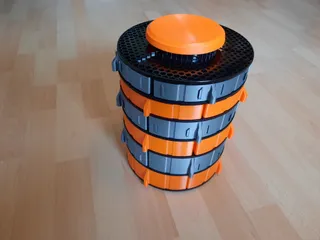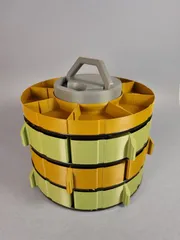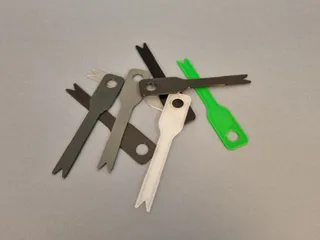PRUSA Sorting Tower MK2 - VaseMode
Description
PDFThis is an upgraded version of my previous design, which now includes a more steady base, an "open layer" addition and a print-in-place top with handle.
The tower is meant as a method of recycling Prusament spools, but can also be made by printing the "extra layer" model instead of using Prusament spools.
Alternatively i have also made a non-vasemode version:
https://www.prusaprinters.org/prints/55640-prusa-sorting-tower-mk2
Layers from this version can also be used together withthe other sorting tower models, as the connectors, are the same:
https://www.prusaprinters.org/social/45936-fredslund/collections/46337
Print instructions
Throughout these instructions, the model names and materials will be bold, so it is easy to navigate.
Materials and Printing
Base, Connectors and Top:
The Base, Connectors and Top are the parts carrying the weight of the tower, and they are all assembled with threads. Therefor PETG is recommended as it is strong, and have a smooth surface that provide low friction and thereby minimize the risk of the threads binding to much. The parts can also be printed in PLA without problems.
For These parts layer height only affects the looks, so they can be printed with standard print settings.
Springs:
The spring is recommended to be printed in PETG as it is strong an yet flexible, if the material is to rigid it will break. printing the spring in one of the plane Prusament PETG's without any glitter, will provide a very well functioning spring.
When Printing the Spring make sure that the actual spring is printed as massive, this can be ensured by raising the number of perimeters. Layer height does not affect the result.
Draws and Open Layers:
The Draws and Open Layers can be printed in any material, I myself have printed them in PLA as it makes the Drawers slightly more rigid, so they don't deform to much when opening.
When Printing the Draws and Open Layers, it is recommended to use Spiral vase, as this gives a very nice looking result. I have personally used Spiral Vase and a 0.6mm nozzle.
However, if you wish to print more than one drawer at the time, or you think the sides are to thin, the following settings can be used to achieve similar results.
Perimeters - set to any number above 1, the higher the number the thicker the walls, and the stronger the drawer.
Solid Layers -> Top - set to 0 to make the draw a open model.
Ensure vertical shell thickness - disable to avoid random infill.
Infill - set to 0 to make a empty drawer.
With these settings you can fill the build plate with as many models as you want.
Assembly
Step 1 - Disassemble Prusament Spool:
The prusament spool consist of two plastic sides held together by a cardboard cylinder, the sides are simply pushed into the cardboard cylinder, and can just be pulled apart. If you don't have any prusament spools, you can either print the Extra Layer model or make a disc out of wood or other rigid material, where the disc has an outer diameter of 20cm and a hole in the center with a diameter of 5cm. Both the Extra Layer and a wooden disc can replace one spool side.
Step 2 - Base:
The Base is placed on a flat surface, place a spool side on the base with outside of the spool side down towards the Base.
Step 3 - Drawers:
The Drawers comes in 3 sizes low, medium and high, which refers to the height of the drawer which is 25, 35 and 45mm respectively. Furthermore each height comes with either one room or two rooms, and each can be chosen to have an integrated label holder. To give an overview of the naming system there is here an example:
Draw_High_1Room - a 45mm tall draw with 1 room and no label holder.
Draw_Medium_2Rooms - a 35mm tall draw with 2 rooms and no label holder.
Draw_Low_2Rooms_2Labels - a 25mm draw with 2 rooms and two label holders.
In order to make one layer, 4 draws in the same height must be made. The drawers are then placed on top of the spool side from Step 2.
Step 4 - Spring:
The spring is added to the assembly, by putting the tabs(the 4 pointy things at the end of the springs) into the slid on the back of each draw.
Step 5 - Connectors:
The connectors comes in three sizes matching the drawers, low, medium and high. A connector in the same size as the drawers are the screwed down into the base. The connectors both holds the spring in place, but also allow for the mount of another layer. On top of the connector another spool side is placed, with the outside pointing down towards the connector.
If you want to add more layers, repeat Step 3-5.
Once you have enough layers, move on to **Step 6.
Step 6 - Top:
A Open Layer can be added on top of the spool side, and finally the top can be screwed on.
The Top comes in two varieties, one with and one without handle. The Print-In-Place top with handle is named Top_Handle and the one without is simply Top.
Happy Printing! Happy Sorting! and don't forget to upload a picture of your final tower! How tall can you make it?
Tags
Model origin
The author remixed this model.





